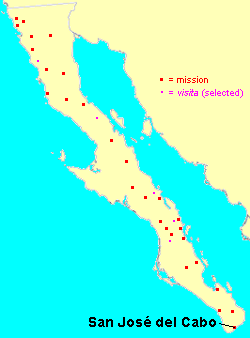Misión Estero de las Palmas de San José del Cabo Añuití

.jpg/440px-Misión_de_San_José_del_Cabo_Añuití_(24075592241).jpg)
Mission San José del Cabo or San José del Cabo Cathedral (est. 1730) was the southernmost of the Jesuit missions on the Baja California peninsula, located in the outskirts of the modern city of San José del Cabo in Baja California Sur, Mexico.
The southern cape of the Baja California peninsula had been an often-visited landmark for Spanish navigators (as well as English privateers) for nearly two centuries when a mission was finally established at the Pericú settlement of Añuití in 1730 by Nicolá Tamaral.[1] The Río San José, or San José River, stops just shy of the ocean, with a one km long sand bar creating an estuary, the third largest in Mexico.[2] This pooling of brackish water has created an oasis in the surrounding Sarcocaule desert. The Río San José flows largely underground for 40 kilometres (25 mi) from its origin in the Sierra de la Laguna (Laguna Mountains).[3] For more than 250 years it has furnished drinking and irrigation water for the town of San Jose del Cabo, beginning as a source of fresh water for Spanish galleons traveling back from the Philippines.[4] Over the sand bar from the estuary is a bay referred to by early Spanish explorers, including Sebastian Vizcaino, as the Bahía de San Bernabé or Bay of San Bernabé (now the Bay of San José del Cabo).[5] Initially located near the beach, the station was subsequently moved inland about 8 kilometers. The mission was founded in 1730 on the west bank of the nearby Río San José, and its full name is taken for the life-giving freshwater estuary.
In 1734 the Pericú Revolt broke out, Tamaral was killed, and the mission was destroyed. In 1735–1736, the reestablished outpost was moved back closer to the coast, but it served as a visita for Mission Santiago and as the site of a Spanish presidio. In 1753, San José del Cabo was again moved inland. In 1795, under the Dominicans, the surviving native population of Mission Santiago was transferred to San José del Cabo. The mission was finally closed in 1840.
In the early 20th century, the mission was damaged by several storms and it was subsequently expanded and renovated. A storm in 1958 destroyed the Revival wooden roof.
-
Interior of Mission San Jose del Cabo
-
Virgin of Guadalupe in Mission San Jose del Cabo
-
Interior of Mission San Jose del Cabo
See also
References
- ^ John L. Kessell (27 February 2013). Spain in the Southwest: A Narrative History of Colonial New Mexico, Arizona, Texas, and California. University of Oklahoma Press. pp. 232–. ISBN 978-0-8061-8944-4.
- ^ "Rescatarán el estero de San José del Cabo, oasis protegido". NOTIMEX. Mexico City. May 11, 2008.
- ^ Gustav Eisen (1897). "Explorations in the Cape Region of Baja California". Journal of the American Geographical Society of New York. 29 (3): 271–280. JSTOR 197262.
- ^ Encyclopædia Britannica, Second edition, 1778, Edinburgh, page 1580. Scan of page can be found at http://www.hyzercreek.com/britannica.htm
- ^ Peter Masten Dunne. University of California Press. pp. 4–. GGKEY:FK94TH92Q55.
Further reading
- Vernon, Edward W. 2002. Las Misiones Antgi: The Spanish Missions of Baja California, 1683–1855. Viejo Press, Santa Barbara, California.


